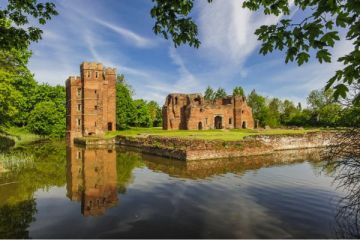Part 2 of 4
See Part 1| Part 3| Part 4
By the time he turned 18, his schooling, and his frequent visits to British relations such as his grandmother, the Marchioness of Milford Haven, had turned the Prince into a true English Royal. And what better place could there be for an Englishman to prove his worth than in the Royal Navy, especially as the dark clouds of war began to gather over Europe? On May 1, 1939, much to the delight of his family – especially his uncle and mentor, Louis Mountbatten – Prince Philip began his naval career at Dartmouth College as a Special Entry Cadet.
In addition to distinguishing himself by winning both the prestigious King’s Dirk and the prize for best cadet of his entry, something else rather important took place during his training year. On July 22, a mere two months into his time at Dartmouth, the Royal Family visited the naval college – some say at the suggestion of Louis Mountbatten – and the Prince received his first proper introduction to Princess Elizabeth, then a shy 13-year-old.
By all accounts – most famously that of the young Princess’s nanny, Crawfie – the meeting was an overwhelming success. Certainly, it gave rise to a special and lasting bond between the two distantly related youngsters, despite the fact that, at 18, Philip was five years older than “Lilibet” and had a very healthy interest in girls of his own age. However, as war broke out, Philip was forced to put aside all thoughts of home and family.
In 1940, he joined HMS Ramillies in Colombo as a Midshipman. For the first six months of his active service, Prince Philip patrolled the Indian Ocean escorting troops from Australia to the Middle East. By January 1941, he had been transferred to HMS Valiant, a battleship stationed in Alexandria. It was on this ship that his talents were truly recognised.
In night action against the fascist Italian fleet off Cape Matapan, the Prince was entrusted with the Valiant’s searchlight control, a duty he performed so well that it led to his being mentioned in dispatches. “Thanks to his alertness and appreciation of the situation, we were able to sink in five minutes two eight-inch-gun Italian cruisers,” remembered the ship’s impressed captain.
After patrolling the East Mediterranean for most of 1941, and having been promoted to Sub-Lieutenant, the Prince returned to Britain. Following a number of demanding but necessary technical courses, he became a crew member on HMS Wallace, a destroyer engaged in escort duties on the east coast of Scotland.
By summer 1942, Philip was a fully-fledged Lieutenant; by October the same year, he had reached the rank of First Lieutenant. The promotion effectively made him second-in-command of the Wallace, an achievement made all the more remarkable by the fact that he was only 21 – an almost unprecedentedly early age for such a honour.
A year later, HMS Wallace and her young First Lieutenant were drafted in to help provide cover for the Allied landings on Sicily, just as the tide of the war began to turn against the Nazis and their allies. From July 1944 until the beginning of 1946, Prince Philip was First Lieutenant aboard the newly built Fleet Destroyer HMS Whelp, stationed in the Pacific theatre of war. As part of the 27th Destroyer Flotilla, the Prince was present in Tokyo Bay when the Japanese finally signed the surrender after the two atomic bombs had been dropped on Hiroshima and Nagasaki.
Prince Philip’s long but distinguished war was over by January 1946, and he returned to Britain. Shore leave, for the Prince as for any sailor, had been a luxury, and it is significant that he spent so much of his precious leave back in England and that he corresponded with “Lilibet” on as regular a basis as the war would permit. In fact, he had been invited to spend Christmas 1943 with the Royal Family at Windsor Castle, an invitation he eagerly accepted.
It was, according to those present, this brief Windsor sojourn which proved decisive in the shaping of his relationship with the 17-year-old Princess. Far from the horrors of war, the two young Royals laughed, joked, and danced together until late into the night. And when Philip left to return to his ship, it was safe in the knowledge that he was in the thoughts of “Lilibet” – and that she would be writing to him as often as possible.
Amazingly, the rumours and court whispers which had circulated for the previous few years seemed finally to be gaining currency. At last, it seemed that the woman who would one day become Queen had chosen her consort: a dashing young war hero who also happened to be the Prince of Greece and Denmark.
This is Part 2 of a 4 part profile
Part 1
Part 3
Part 4

Contents copyright 1999-2001 The Royal Report
NOTE: The Royal Report is sadly no longer online.



